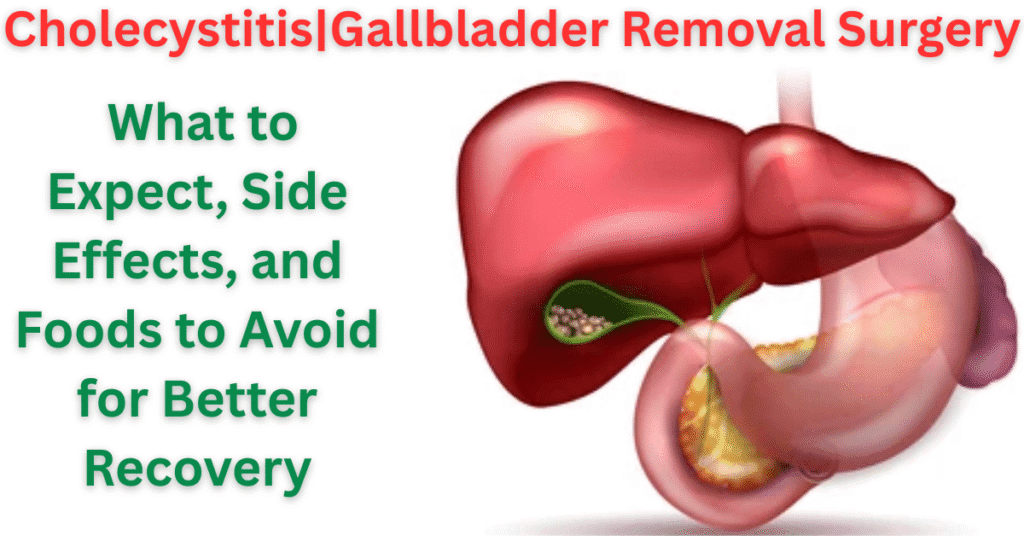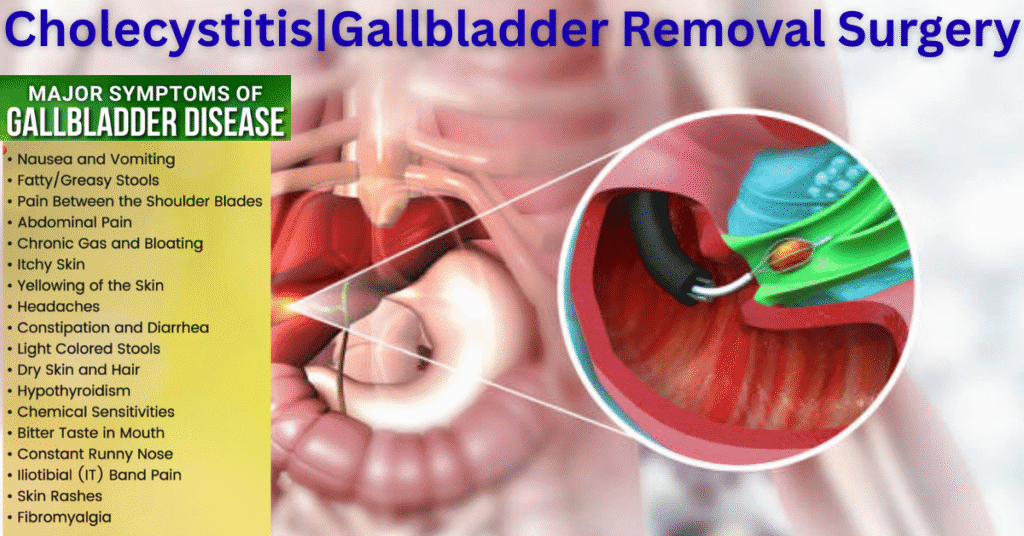
Table of Contents
Cholecystitis|Gallbladder Removal Surgery
Cholecystitis|Gallbladder Removal Surgery : Gallbladder removal surgery, medically known as cholecystectomy, is one of the most common procedures worldwide. It is usually recommended for people suffering from gallstones, gallbladder inflammation, or bile duct obstructions. While the surgery can offer life-changing relief from chronic pain and digestive issues, it may also bring about certain digestive side effects and require lifestyle changes.
Understanding what happens after surgery, potential complications, and necessary dietary adjustments can significantly improve recovery and long-term well-being.
What Happens After Cholecystitis|Gallbladder Removal?
The gallbladder stores bile — a digestive fluid produced by the liver to help break down fats. Once the gallbladder is removed, bile flows directly into the small intestine, rather than being stored and released during meals. While most people adapt over time, some may initially face difficulties digesting fatty foods.
Common Side Effects After Cholecystitis|Gallbladder Surgery
1. Difficulty Digesting Fatty Foods
Without the gallbladder regulating bile release, fat digestion becomes less efficient. Many patients report bloating, indigestion, or abdominal discomfort, especially after consuming fried or greasy meals.
2. Diarrhea and Gas
One of the most common side effects is diarrhea, triggered by continuous bile flow into the intestines. A low-fiber or high-fat diet can make it worse, often leading to flatulence and urgency.
3. Constipation
Though the surgery typically resolves gallstone-related constipation, anesthesia or pain medication can temporarily slow bowel movements. Staying hydrated and eating high-fiber foods can ease this issue.
4. Rare Complications
In rare cases, complications like intestinal injury, infection, or bile duct blockages may occur. Symptoms such as persistent pain, jaundice (yellowing of skin and eyes), or high fever should prompt immediate medical attention.
Why Is Cholecystitis|Gallbladder Removal Necessary?
Cholecystectomy is often performed to resolve or prevent serious health issues related to a malfunctioning gallbladder. Common conditions include:
- Gallstones (Cholelithiasis): Solid deposits of cholesterol or bile salts causing pain and blockages.
- Cholecystitis: Inflammation of the gallbladder, often due to gallstones.
- Bile Duct Obstruction: Blockage caused by stones or tumors leading to jaundice or infection.
- Gallbladder Dysfunction: Poor gallbladder performance causing chronic digestive issues.
Removing the gallbladder prevents complications like infection, rupture, or severe pancreatitis, and most people continue to live healthy, normal lives without it.
Diet After Gallbladder Removal: What to Eat and Avoid
Your digestive system needs time to adjust after surgery. A proper diet can ease recovery and minimize side effects.
1. Immediately After Surgery
For the first 24 to 48 hours, doctors recommend a liquid or bland diet including:
- Clear broth
- Plain rice
- Mashed potatoes
- Yogurt
These gentle foods give the digestive tract time to rest and recover.
2. Gradual Reintroduction of Foods
As your body heals:
- Avoid fried, fatty, or spicy foods in the beginning.
- Drink plenty of water to avoid dehydration and help regulate digestion.
- Eat fiber-rich foods such as carrots, spinach, apples, and oats to support bowel health.
- Slowly reintroduce gas-forming vegetables like broccoli and cabbage to avoid bloating.
3. Long-Term Dietary Habits
Once recovered, you can resume a mostly normal diet. However, these habits can prevent future issues:
- Low-fat, high-fiber meals
- Small, frequent portions instead of large meals
- Choose healthy fats like olive oil over saturated fats
Are There Alternatives to Surgery?
If your gallbladder condition is mild or manageable, non-surgical options may help — but always consult your doctor first.
1. Lifestyle Changes
- Maintain a healthy weight to reduce gallstone risk.
- Eat more plant-based foods and fewer animal fats.
- Engage in regular physical activity to promote bile flow.
2. Natural Remedies and Supplements
While not a substitute for medical treatment, some people find relief through:
- Apple cider vinegar and turmeric: May have anti-inflammatory benefits.
- Magnesium and choline: Potential to reduce gallstone formation.
- Acupuncture: May help improve bile movement and reduce discomfort.
- Gallbladder cleanses (e.g., olive oil + lemon): Use only with medical supervision, as evidence is limited and risks exist.
When to See a Doctor After Surgery

You should seek immediate medical attention if you experience:
- Severe or persistent abdominal pain
- Yellowing of skin or eyes (jaundice)
- High fever or chills
- Vomiting or inability to keep food down
- No bowel movements or gas for more than 3 days
- Diarrhea lasting longer than 3 days
GallbladderSurgery #Cholecystectomy #DigestiveHealth #PostSurgeryCare #HealthyLiving #LowFatDiet #Gallstones #RecoveryTips
Conclusion
Gallbladder removal surgery can offer lasting relief and prevent serious health complications, but it’s essential to understand the side effects, follow a supportive diet, and adopt healthy habits. Most patients recover fully and live healthy lives by making a few mindful adjustments.
Whether you’ve undergone surgery or are exploring options, working closely with your healthcare provider ensures the best outcome for your digestive health.


